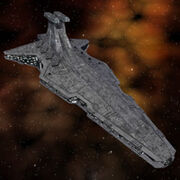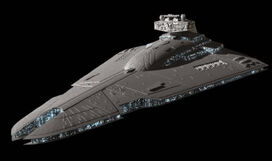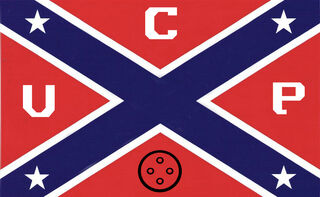| ||||||||||||||||||||||||||||||||||
The UCP Crisis, also know as the UCP Rebellion, was a brief yet vicious civil war that erupted in the Stonewall System. The United Confederate Planets formed after the Stonewall Federation raided Bragg's munitions storage on the planet and confiscated thousands of small arms and warships after the planet's refusal to add their weapons to the Federation's Space Corps. This action caused widespread anger throughout several planetary members' governments, causing Cleburne, and Cheatham to threaten secession. War erupted, leading to a split Stonewall Federation.
Background[]
The crisis begins[]
Tensions surrounding the break out of all out war began at the end of January in 12 NE when the Stonewall Federation began to crack down on its member planets for possessing "weapons of war". All planets in the Federation had agreed to decommission or hand over warships, weapons, and other vehicles to the Federation government to add to their own forces.
By the end of January, most planets had done precisely that, except for two: Bragg and Cleburne. Both planets filed lawsuits against the Federation government, however the motion was rejected by the courts because both member planets had signed the agreement when adopting the constitution almost a year earlier.

A Venator I-class Star Destroyer that was commonly used by the UCP. Pictured is the Redemption.
It was thought that the new Chancellor, Theodore Jackson, would not push for the demilitarization of the two hold out planets, however he proved the speculators wrong. On February 1 of 12 NE, Federation special forces launched a raid on Bragg at night, capturing over two-hundred and fifty aged warships and thousands of small arms; five Bragg citizens were killed in the minor fire fight.
The act brought outrage from Bragg's planetary government, and it threatened secession if the Federation government did not back down. By February 5, both of Bragg's congressional houses had ratified the Articles of Secession nearly unanimously and declared secession the next day. Cleburne followed suit, offering weapons and ships to Bragg. A week later, Ramseur and Wirz had declared secession, revealing their own aged Imperial II-class and Venator I-class Star Destroyers. On February 14th, the four renegade planets had formed a loose confederacy style government and had declared war on the Stonewall Federation. Following the declaration of war, several thousand military men and women resigned their positions in the Stonewall Federation Space Corps and the Stonewall Federation Terrestrial Division.
Combat Operations[]
Battle of Stonewall[]

A Federation-class Star Destroyer, used by the Stonewall Federation. Pictured above is The Envoy
Less than two days after the declaration of war, the UCP launched an attack on the Federation's capital, bombarding it from orbit before the planetary shields could be activated. Then Captain Jared Oelka was in charge of the UCP's attack, with nearly three hundred fifty warships at his disposal for the operation. He tasked nearly sixty of them to lay waste to the Federation's shipyards near the planet and also at Lee, catching the Federation off guard.
However, the Federation's warships reacted quickly, confronting Oelka's fleet quickly. Supreme Commander William Bedford Forrest was the commanding officer, and ordered Oelka and his fleet to stand down immediately. Oelka refused, and continued firing on the Federation fleet. Eventually, the Stoneall Fleet was reinforced and caused the renegade fleet to retreat back to Cleburne.
Blockade of Cleburne[]
In response to the attack on Stonewall, Supreme Commander William Bedford Forrest staged a blockade of Cleburne, with ships numbering around 50,000. Ships were not allowed to enter or leave the perimeter. Heavy fighting erupted inside the blockade between several Cleburne vessels and Federation forces. It turned out this skirmish was intended as a distraction, as a large UCP fleet jumped in to the area around the blockade and broke through. Many ships from both sides were destroyed, with a large amount of lives lost in this particular battle. Early casualty estimates put the number at nearly 20,000 lives lost. The commander of the Stonewall forces, unable to beat back the large UCP fleet, retreated to Lee to prepare for a decisive strike against Cleburne.
Second Battle of Cleburne[]
A week after the Stonewall Federation's disastrous defeat at Cleburne, a counter strike was launched. Three different battle groups entered space around the planet and viciously attacked UCP forces. The Cleburne portion of the fleet surrendered, while the rest of the UCP fleet retreated to Semmes and Cheatham. Supreme Commander Forrest personally led the counter-strike on Cleburne, resulting in a victory for the Federaiton. However, many ships and lives were lost in the undertaking, causing Chancellor Jackosn to suffer a blow to his popularity ratings.
Battle of Semmes[]
A month following the counter strike at Cleburne, Federation forces launched a final campaign at the heart of the UCP's military located at Semmes. Semmes was heavily fortified and was the base for the remaining UCP forces. Unknown to Federation forces, Robert Stanforth was in charge of the UCP forces. He led the defense of Semmes. Forrest led the Federation forces onboard his flagship, The Envoy. The battle lasted for several days, however Federation forces were victorious in defeating a majority of the UCP fleet. As the battle came to a close, Stanforth fled, fearing capture from the Stonewall Federation.
Due to the UCP defeat at Semmes, Wirz and Ramseur surrendered without a shot being fired and turned over their warships to the Federation government.
Aftermath[]
- "The war may be over, but the rebuilding must begin. It is foolish of us to fight amongst ourselves. The Federation government must work harder to maintain positive relations with planetary governments so this never happens again."
- ―Chancellor Theodore Jackson addressing the Federation on the eve of the surrender of the UCP.
With the war ended, the Confederate Jedi Order was utilized, as it was a part of the Justice Department, to oversee the decomissioning of the UCP warships. Many of these warships would be refitted and put into service with the Stonewall Federation Space Corps, with many being stationed at their homeplanets.
Chancellor Jackson emphasized that the Stonewall Federation would have to treat it's member planets better and be more understanding to avoid another catastrophe such as this. Furthermore, he refused to criminally prosecute any person who served in the UCP's government or its armed forces, despite the public wanting trials for the top leaders. Jackson refuted that logic with, "We are all brothers and sisters, and we all make mistakes. There is plenty of blame to cast about, and not only on those who served for the UCP and their home planets."
The years following the UCP Crisis saw a softer approach to the style of governance from Jackson's Chancellry office. However, there was still wide spread anti-Jedi sentiment, along with enough disgruntled officers to launch the Privarz Rebellion several years later.
